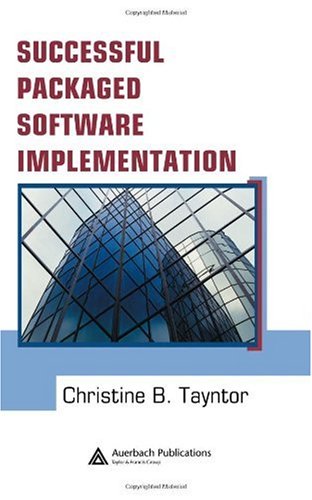

Most ebook files are in PDF format, so you can easily read them using various software such as Foxit Reader or directly on the Google Chrome browser.
Some ebook files are released by publishers in other formats such as .awz, .mobi, .epub, .fb2, etc. You may need to install specific software to read these formats on mobile/PC, such as Calibre.
Please read the tutorial at this link. https://ebooknice.com/page/post?id=faq
We offer FREE conversion to the popular formats you request; however, this may take some time. Therefore, right after payment, please email us, and we will try to provide the service as quickly as possible.
For some exceptional file formats or broken links (if any), please refrain from opening any disputes. Instead, email us first, and we will try to assist within a maximum of 6 hours.
EbookNice Team

Status:
Available4.8
11 reviews
ISBN 10: 0849334101
ISBN 13: 9780849334108
Author: Christine B Tayntor
Successful Packaged Software Implementation guides IT departments through the selection and implementation of packaged software, pointing out potential pitfalls and how to avoid them. Offering a step-by-step approach, this volume begins with an assessment as to whether packaged software is the correct solution. It then analyzes the product selectio
Part I: Planning
Chapter 1: The First Steps
Criteria for Success
The Need for a Formal Selection Process
Step 1: Form the Selection Team
The Project Charter
Team Selection
The Team Leader
Facilitators
Outside Advisors
Chapter 2: The Selection Process
Identifying Requirements and Potential Products
Step 2: Identify and Prioritize Requirements
Identifying Requirements (Functional, Technical, Vendor-Related)
Prioritizing Requirements
Step 3: Identify Potential Products
RFPs and RFIs (Request for Proposals, Request for Information)
Ranking RFP Sections
Product and Vendor Evaluation
Step 4: Team Evaluates the Responses and Creates the Short List of Vendors
Step 5: Team Schedules Vendor Presentations
Step 6: Team Checks Vendor References
Step 7: Short List Vendors Present Their Products (Standard Demo) and Capabilities
Chapter 3: Legal Issues—Contracts and Software Licenses
Introduction
Definitions
Term
Termination
License
Deliverables
Schedule for Deliverables
Maintenance (If Contained in the Base Software License)
Fees and Payment Terms
Confidentiality and Protection of Data
Representations and Warranties
Indemnification
Limitation of Liability
Miscellaneous Provisions
Chapter 4: Implementation Considerations
Establishing the Roadmap
Who Is In Charge? (Program Management Office, Other Key Decisions)
The Champion
The Implementation Team
Selling the Solution
What Is Involved?
Step 1: Calculate the Costs of the Proposed Solution
Step 2: Calculate the Costs of the Current Process
Step 3: Identify the Benefits of the Proposed Solution
Step 4: Calculate Return on Investment
Step 5: Outline the Implementation Schedule
Step 6: Develop the Business Case and Presentation
Step 7: Presell the Solution
Step 8: Present the Solution
Organizational Readiness
The Basics of Change
Roles Associated with Change
The Impact of Change
Components of Successful Change
The Critical Element: Communication (Formal, Informal, Rumor Mill)
Coping with Conflict
Part II: Implementation
Chapter 5: The Ground Rules
The Need for a Rule Book
Step 1: Establish and Publish Standards
Need for Review and Approval
Step 2: Develop and Monitor the Schedule
Step 3: Define and Implement Change Management
Step 4: Create and Follow Communication Protocols
Chapter 6: Software Installation
Step 1: Prepare the Infrastructure
Step 2: Install Vanilla Code
Step 3: Test the Vanilla Code with Vendor-Supplied Data
Step 4: Test the Vanilla Code with Your Data
Chapter 7: Configuration
Purpose of Configuration
Configuration vs. Customization
Steps to Configuration
Chapter 8: Interfaces and Conversions
Defining Interfaces
The Interface Design Document
Types of Interfaces
Data Conversion
Chapter 9: Customizations
The Customization Dilemma
When Customization Is Necessary
Managing Customizations
Chapter 10: Training
Project-Team Training
End User Training
Ongoing Training
The Challenges of Multisite Implementation
Chapter 11: Testing
The Importance of Testing
Types of Testing
Developing a Test Plan
Test Cases and Scenarios
User Acceptance Testing (UAT)
Managing Defects
Part III: Post-Implementation
Chapter 12: Support
Establishing End User Expectations
Step 1: Create a Steering Committee
Step 2: Establish Service-Level Agreements
Step 3: Implement a Mechanism for Capturing and Reporting Performance
Step 4: Communicate Performance Metrics
Determining Who Will Provide Support
The Legacy System Dilemma
Chapter 13: The Future
The Postmortem
The Control Plan
Legacy System Decommissioning
Acquisitions and Divestitures
software implementation book
successful information system implementation examples
software package implementation
prepackaged software
software implementation steps and procedures pdf
packaged software producers create software such as
a recommendation for erp software implementation success is
Tags: Christine B Tayntor, Software, Implementation